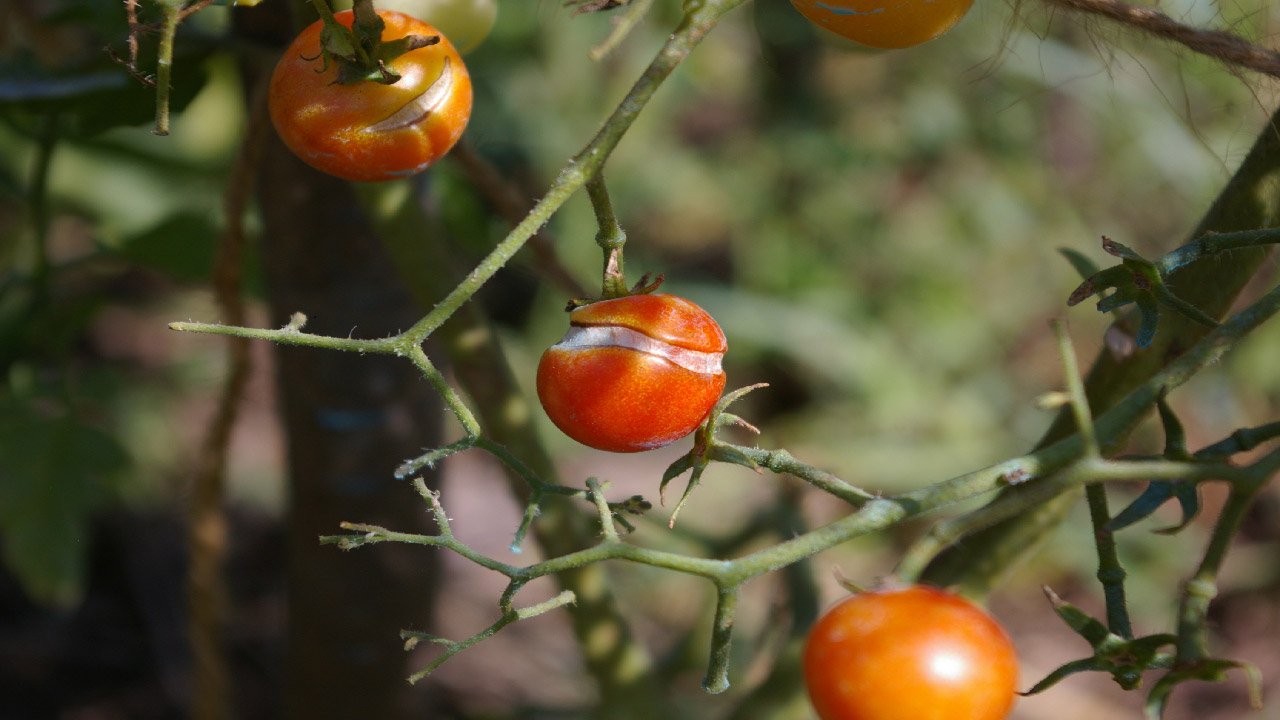It is a common occurrence for gardeners to notice their tomatoes splitting while still attached to the vine, whether the fruits are in the early green stage or fully ripened. If you cultivate tomatoes, you have likely observed your carefully nurtured crop reaching peak ripeness, only to find that the tomatoes you’ve been anticipating for sandwiches or salads have suddenly developed splits overnight (rest assured, they remain perfectly edible despite the cracks!).
Below, we will thoroughly examine the reasons behind tomato splitting and provide actionable steps to minimize this issue.
The Science Behind Tomato Splitting: Primary Causes and Mechanisms
In straightforward terms, tomatoes split due to one of two key factors: excessive water intake or abrupt fluctuations in moisture levels. When tomato plants transition from a prolonged dry period to an intense rainfall, the sudden influx of water causes the inner flesh of the tomatoes to expand more rapidly than the outer skin can accommodate, resulting in visible cracks and splits.
While both major types of cracking can potentially create entry points for pests or encourage rot, concentric cracking (circular cracks near the stem) is often less severe. If the cracking is superficial and does not expose the interior pulp, the tomato can remain on the vine to continue ripening—however, close monitoring is advised. Young green tomatoes that develop splits are far more susceptible to rotting before reaching maturity compared to older fruits that crack later in their growth cycle.
A Detailed Breakdown of the Two Main Types of Tomato Cracks
Tomatoes exhibit two distinct forms of splitting:
- Vertical Splits (Radial Cracking): These cracks originate at the top of the fruit and extend downward in a straight or slightly jagged line toward the bottom.
- Concentric Splits (Circular Cracking): These cracks form in ring-like patterns around the stem area and are most frequently observed in larger heirloom tomato varieties.
How to Prevent Tomatoes From Splitting
Maintaining consistent soil moisture is the most effective way to prevent splitting. While it’s impossible to completely eliminate the risk—especially after unexpected heavy rainfall—the following methods can significantly reduce the likelihood of your tomatoes developing cracks:
- Implement a Regular and Deep Watering Schedule: Tomato plants require approximately one inch of water per week. During the summer months, water deeply every two to three days. Use the finger test: insert your index finger one inch into the soil—if it feels dry, watering is needed.
- Direct Water at the Base of the Plant, Avoiding the Leaves: When irrigating, target the soil around the plant’s stem to prevent soil from splashing onto the foliage, which can spread soil-borne diseases like blight and Septoria leaf spot. Drip irrigation or soaker hoses are ideal for this purpose.
- Harvest Tomatoes Early When Rain is Forecasted: Tomatoes that have begun showing color changes will continue ripening after being picked. Collect them before heavy storms and allow them to finish ripening indoors on a windowsill (an added benefit is reduced pest damage).
- Apply a Protective Layer of Organic Mulch: Spread two to three inches of mulch—such as straw, pine needles, or shredded bark—around the base of plants to regulate soil moisture and minimize splitting.
- Select Tomato Varieties Known for Split Resistance: Review plant labels or seed catalogs for varieties specifically bred to resist cracking. Many hybrid tomatoes offer enhanced disease resistance and lower splitting tendencies.
- Ensure Proper Drainage in Planting Areas: Grow tomatoes in raised beds or containers with adequate drainage holes to prevent waterlogging. Use loose, well-aerated soil to avoid compaction. Note: Container-grown tomatoes lose nutrients faster, so follow fertilizer guidelines.
- Apply Balanced Fertilization with Caution: Use a slow-release tomato fertilizer formulated with higher phosphorus and potassium and lower nitrogen levels. Excessive nitrogen promotes rapid growth, increasing the risk of cracks.
What to Do When Tomatoes Split
If splitting occurs, promptly harvest affected tomatoes to prevent rot and insect infestations. Unripe split tomatoes can be ripened indoors away from pests.
While splitting cannot always be avoided, most affected tomatoes remain edible. Inspect them thoroughly for signs of mold, pests, or fermentation. Discard any fruit that feels overly soft, emits a sour odor, or shows oozing. Split tomatoes have a short shelf life, so consume or cook with them immediately.
Split-Resistant Tomato Varieties
Although no tomato variety is entirely immune to splitting, the following cultivars are known for their reduced susceptibility to cracks (proper growing conditions still apply):
- ‘Big Beef’: Indeterminate hybrid beefsteak (10–12 oz fruits). Matures in 70 days.
- ‘Big Boy’: Indeterminate beefsteak (up to 1 lb fruits). Matures in 78 days.
- ‘Box Car Willie’: Indeterminate heirloom (6–10 oz fruits). Matures in 80 days.
- ‘Celebrity’: Determinate hybrid (8 oz fruits). Matures in 72 days.
- ‘Jet Star’: Indeterminate hybrid (7–8 oz globe-shaped fruits). Matures in 70 days.
- ‘Juliet’: Indeterminate hybrid (1.5–2 oz oblong fruits). Matures in 60 days.
- ‘Mortgage Lifter’: Indeterminate heirloom (1–2 lb pink beefsteaks). Matures in 80 days.
- ‘Pruden’s Purple’: Indeterminate heirloom (1+ lb pink-purple fruits). Matures in 65 days.
- ‘Sun Gold’: Indeterminate hybrid orange cherry tomato (sweet-tart flavor). Matures in 65 days.
Frequently Asked Questions About Tomato Splitting and Related Issues
What causes the bottom of tomatoes to rot?
Blossom-end rot—a dark, leathery patch at the fruit’s base—stems from calcium deficiency, typically due to irregular watering.
Are cracks always a sign of overwatering?
Not exclusively. While overwatering after drought is a leading cause, other factors include waterlogged soil, calcium deficiency, over-ripening, and excessive sun exposure.
Which nutrient deficiency leads to tomato cracking?
Insufficient calcium in the soil is a primary contributor. Tomato-specific fertilizers can address this.
Why do picked tomatoes sometimes split?
Over-ripening post-harvest may cause splits, but the tomatoes remain edible if no rot is present.

